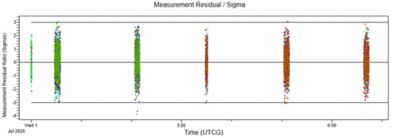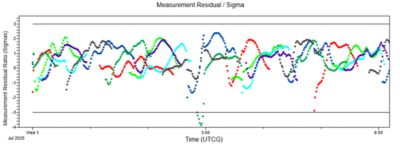-
-
Kostenlose Software für Studierende
Ansys unterstützt die nächste Generation von Ingenieur*innen
Studenten erhalten kostenlosen Zugang zu erstklassiger Simulationssoftware.
-
Verbinden Sie sich jetzt mit Ansys!
Gestalten Sie Ihre Zukunft
Stellen Sie eine Verbindung mit Ansys her, um zu erfahren, wie Simulation Ihren nächsten Durchbruch vorantreiben kann.
Länder und Regionen
Kostenlose Demoversionen
Produkte & Dienstleistungen
Lernportal
Über das Unternehmen
Back
Produkte & Dienstleistungen
Back
Lernportal
Ansys unterstützt die nächste Generation von Ingenieur*innen
Studenten erhalten kostenlosen Zugang zu erstklassiger Simulationssoftware.
Back
Über das Unternehmen
Gestalten Sie Ihre Zukunft
Stellen Sie eine Verbindung mit Ansys her, um zu erfahren, wie Simulation Ihren nächsten Durchbruch vorantreiben kann.
Kostenlose Demoversionen
ANSYS BLOG
February 27, 2024
Assessing the Validity of Orbit Determination Runs
This article kicks off a three-part series on orbit determination (OD), the challenges of accessing the quality of an OD, and a novel approach to automate OD quality analysis. In this blog, we discuss what orbit determination is, why we do OD, and the challenges of knowing if your results are valid.
There are numerous methods to track a satellite, such as using a telescope, radar, lasers, or other approaches. While these methods can give you some information about the satellite's location, none of them provide you with an orbit or a way to predict the location of the satellite at any point in time. Tracking a satellite with a telescope, for example, will give you the direction from the telescope to the satellite each time you take a measurement, but information on orbital elements, propagated ephemeris, or the environment affecting the satellite can only be found by processing results with an orbit determination tool.
What is Orbit Determination?
Orbit determination is the estimation of orbits of spacecraft, natural satellites, or binary stars relative to primary celestial bodies, given applicable measurements.

Why Do We Perform Orbit Determination?
Satellite operators need to know where their satellite was and where it will be going. For a spacecraft collecting scientific data, for example, it is often essential to know the precise location of where data was gathered. The trajectory also needs to be predicted accurately into the future to:
- Schedule data uplinks and downlinks.
- Predict conjunctions with other satellites and, if necessary, maneuver to avoid collisions.
- Schedule tracking passes to continue orbit determination in the future.
- Accurately plan any required orbit maintenance maneuvers.
- Collect data. If the location of a spacecraft is not well-known, it is impossible to accurately point sensors at a desired target.
Without an accurate OD run and confidence that it is valid, future satellite operations may be inaccurate. The satellite won’t be over the uplink/downlink stations at the expected times, meaning antennas will be pointed in the wrong direction. Close approaches with other satellites will change, possibly adding new conjunctions with satellites that were not accounted for. Maneuvers may be planned in a suboptimal way, wasting precious fuel.
What Are the Challenges of Orbit Determination Analysis?
Unless there is a significant error, any orbit determination run will give you results. It’s not until you investigate these results further that you can determine if the run was actually “good.” For example, a bad initial state of your satellite or being overly confident in the quality of your tracking data can result in most (or all) of your measurements being rejected. You would then end up simply propagating your initial state instead of being able to use the new measurements to correct the orbit throughout its path. While this should be detected by any orbit analyst running OD, there are more nuanced issues that may not be obvious to everyone and may be missed by less experienced analysts.
How Do You Know Your Results are Correct?
There is no single test that determines whether a run was valid or not, so finding instances that indicate problems is often a lot easier than proving a run is valid. Proving accuracy is mostly about analyzing graphs of the OD results and not detecting any behavior that could point to irregularities.
Using a simple example as a starting point, the residual ratios graphs below show which tracking measurements were processed by the OD run and which were rejected. Residual ratios are a normalized metric that provide the difference between the actual measurement and the expected measurement value. To ignore bad measurements, every measurement with a residual ratio outside –3 and 3 sigma will be rejected because the measurement error is larger than anticipated.

Residual ratios plot with a significant number of rejected measurements

Residual ratios plot with accepted measurements
The example above looks good: Measurements are spread between –3 and 3 sigma in a Gaussian (white noise) manner, with only a few rejected measurements. Simply looking at whether measurements were accepted may not tell you the whole story, though. While most measurements were accepted in the graph below, they do not exhibit the expected white noise behavior, which hints at problems with the force model, among other issues.

Residual ratios plot with a potential force model issue
Beyond residual ratios, there are several possible checks for the orbit analyst to validate, such as what’s shown in the position consistency and histogram graphs below. For example, does the position estimate of the filter run agree with the position estimate of the smoother run? Do the drag and solar radiation pressure estimates agree, and is the tracking station calibrated correctly? Was the estimate of a maneuver close to how the satellite was expected to perform? Ultimately, determining if an OD run is good rests on the intuition and experience level of the orbit analyst.

Position consistency plot

Histogram plot
Moving Forward
While it’s relatively easy to recognize obvious issues with an OD run, it sometimes takes an experienced orbit analyst to detect problems beyond the obvious. So, how can we extend the experience of the seasoned analyst to a new analyst? In part two of this series, we will talk about how we are tackling this problem by using AI in Ansys Orbit Determination Too Kit (ODTK) to automate OD quality analysis.